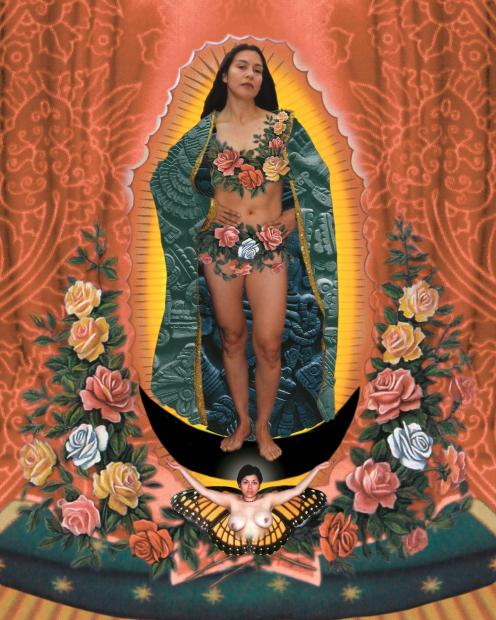 I love art. I especially love certain women’s art – women such as Frida Kahlo, Cathy Ashworth, Sudie Rakusin, and Alma Lopez. To me, their art is a reflection of women’s strength, creativity, and beauty. Frida Kahlo, for example, expressed so many aspects of herself and her experience through her art. In it one can glimpse her passionate love for Diego Rivera, her continuous physical pain, her search for meaning, and the unending hopefulness she maintained throughout it all. Frida Kahlo’s art, like her person, was vibrant and full of life, colorful and yet broken. She expressed the wide spectrum of her experience not in words only but in color and images, texture, paint and print. As she put it, “I paint my own reality” – her own reality is what she knew and it is what she painted.
I love art. I especially love certain women’s art – women such as Frida Kahlo, Cathy Ashworth, Sudie Rakusin, and Alma Lopez. To me, their art is a reflection of women’s strength, creativity, and beauty. Frida Kahlo, for example, expressed so many aspects of herself and her experience through her art. In it one can glimpse her passionate love for Diego Rivera, her continuous physical pain, her search for meaning, and the unending hopefulness she maintained throughout it all. Frida Kahlo’s art, like her person, was vibrant and full of life, colorful and yet broken. She expressed the wide spectrum of her experience not in words only but in color and images, texture, paint and print. As she put it, “I paint my own reality” – her own reality is what she knew and it is what she painted.
I rely on art to do what academics often cannot do well – what I cannot do well – which is to communicate the truths that rattle our being down to its deep core in ways that connect with others. There have been times in my academic life when I have encountered new insights that changed my life forever. Moments of being shaken and awakened at my very core by a truth that until then had eluded me. But such moments can be hard to share with others because they can be hard to translate to words, even if such moments have come to me by words. Learning about feminist theology and being shaken by the truths it spoke to me is one such encounter – and it was indeed an academic one that is often hard for me to put into words and explain to others. On the other hand, encountering Alma Lopez’s artwork was also a core rattling moment, but one which I can more easily share.

Alma Lopez’s Our Lady is a digital art piece in which Our Lady of Guadalupe is depicted (embodied, really) in a more obviously female form than is traditionally expected. For this, every time her piece is on exhibit, Lopez receives a barrage of protest and harassment – as does the sponsoring institution. Accusations of obscenity, profanity, and blasphemy come her way. But, why?
When I see Lopez’s Our Lady, I do not see blasphemy or obscenity, I see a celebration of the female and the sacred. I see the beauty of God’s queer incarnation – and I remember – I remember that the word became flesh and made her home among us. From the womb of a woman’s body, her life-giving body, the divine took human shape. Boundaries of sacred and profane forever blurred.
Alma Lopez, like Frida Kahlo, paints her own reality; she says this piece is a reflection of her relationship with Our Lady of Guadalupe, a divine image that has been part of her life since she was very young. But I also think she reveals something more than just her personal relationship with Our Lady…
From a Christian theological perspective, Our Lady confronts us all with the truth of the Divine’s relationship with women’s bodies – the Word first became flesh in the body of a woman. The boundaries are broken, false partitions collapse – inextricably related – you, me and the Divine. Art can communicate the truths that rattle our being down to its deep core, and judging from the protests Alma Lopez’s work receives, this rattling truth is something many people would rather resist. But to me, Alma’s work will continue to be a reminder of women’s strength, courage, and creativity – it is the reality I know and for which I am forever grateful.
Discover more from Feminism and Religion
Subscribe to get the latest posts sent to your email.


Xochitl,
The image of La Virgin by artist Alma Lopez is rich with sexuality and power, an admixture that must on the one hand be hidden and sanitized while secretly desired and enjoyed. Now map that charged sexuality upon la Virgin and you have outrage. Your post has brought to the surface the power of art to disrupt and transform. Lopez’s depiction allows the beauty of women’s body and its allure to come forward, affirming our sexuality, not hiding it.
Growing up Irish-Catholic Mary was our go-to-person, functioning more like the divine then the three-in-one. I only wish I had Lopez’s version to tell me my body and sexuality are also imago dei, it really would have saved me vast amounts of money in therapy.
Excellent post, thank you for this affirming image.
LikeLike
Thanks Cynthie for your comment. I do love how Lopez’s image does affirm imago dei in women and I do think we need more of that in our lives for sure! That’s part of why I love and need feminism in my life – and my feminist sisters too! :D
LikeLike
And her work is still surrounded by controversy today of course – http://www.corkstudentnews.com/news/in-her-own-words-alma-lopez-on-the-blasphemous-exhibit-21650
But as she says, “the Virgin of Guadalupe is a revolutionary image of indigenous resistance to colonization and genocide,” and it is so important that Guadalupe continue to be so today.
LikeLike
Yes, after I read your post I did some research. I’m ordering the book, Our Lady of Controversy from Lopez. I’ll use her art work when I teach on Mary in my Women and Christianity class this fall. So excited about this medium, thanks again.
One more thing, I think I have been using the word “queer” incorrectly (which is sad since my oldest daughter self-identifies as such.) I have thought it identifies the person as bi-sexual, which I now think it is not necessarily the case. What I found from Teresa de Lauretis is queer as “the idea that identities are not fixed and do not determine who we are.” Is this restricted to sexual preference and as in the case of womanist, can only the queer community self-identify as such? By Lauretis’ defination, this term could be applied in so many areas of our lives.
LikeLike
Cynthie – I found a good quote from Judith Butler that speaks to your question above – I think you will like it: “My understanding of queer is a term that desires that you don’t have to present an identity card before entering a meeting. Heterosexuals can join the queer movement. Bisexuals can join the queer movement. Queer is not being lesbian. Queer is not being gay…Queer is an argument against certain normativity, what a proper lesbian or gay identity is.” –Judith Butler, The Desire for Philosophy: An Interview with Judith Butler
So the term definitely has its roots in how sexuality is understood, but I don’t think it’s restricted to that. The principle of disrupting certain normativities translates into other areas; but I think that to be faithful to the origins of the word, ‘queering’ should be done in the interests of the marginalized against whom the norm is being used as a means to oppress/suppress. If one keeps the material reality and interest of the oppressed and marginalized when thinking about what is considered queer (and advocating it), then I think the term does have a lot of liberating applications in many areas and should be used by many.
LikeLike
A really beautiful reflection! I love your reminder: “the Word first became flesh in the body of a woman. The boundaries are broken, false partitions collapse – inextricably related – you, me and the Divine.”
LikeLike
I showed this image to my co-workers and they were, not to my surprised, appalled.
Traditional believes in Catholicism are very hard to brake, even with all the blood shed that surrounds it’s history. Why are people so afraid of an interpretation that is supposed to represent a celebration of women? An image that disrupts the traditional boundaries of the status quo will always shake peoples mind but isn’t that what art is. Art in it self is a revolutionary act that will stir any structural “Institution” with whatever means it can. I think it is a duty as an artist to keep evolving the conventional ideas and concepts of society, to give us a new perspective of what these traditions really mean & symbolize to “us” now, today, in this moment in our society.
LikeLike